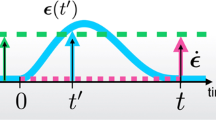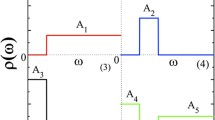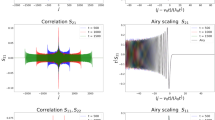Abstract
The high- and low-energy limits of a chain of coupled rotators are integrable and correspond respectively to a set of free rotators and to a chain of harmonic oscillators. For intermediate values of the energy, numerical calculations show the agreement of finite time averages of physical observables with their Gibbsian estimate. The boundaries between the two integrable limits and the statistical domain are analytically computed using the Gibbsian estimates of dynamical observables. For large energies the geometry of nonlinear resonances enables the definition of relevant 1.5-degree-of-freedom approximations of the dynamics. They provide resonance overlap parameters whose Gibbsian probability distribution may be computed. Requiring the support of this distribution to be right above the large-scale stochasticity threshold of the 1.5-degree-of-freedom dynamics yields the boundary at the large-energy limit. At the low-energy limit, the boundary is shown to correspond to the energy where the specific heat departs from that of the corresponding harmonic chain.
Similar content being viewed by others
References
G. Ciccotti and W. G. Hoover, eds.,Molecular Dynamics Simulation of Statistical-Mechanical Systems (North-Holland, Amsterdam, 1986); G. Ciccotti, D. Frenkel, and I. R. McDonald, eds.,Simulation of Liquids and Solids (North-Holland, Amsterdam, 1987).
R. Livi, M. Pettini, S. Ruffo, and A. Vulpiani,J. Stat. Phys. 48:539 (1987).
G. Benettin, L. Galgani, and A. Giorgilli,Nuovo Cimento B 89:89, 103 (1985).
B. V. Chirikov,Phys. Rev. 52:263 (1979).
J. L. Lebowitz, J. K. Percus, and L. Verlet,Phys. Rev. 153:250 (1967).
Y. Elskens, private communication.
D. F. Escande,Phys. Rep. 121:166 (1985).
B. Peters, Memoire de Maitrise, Université de Provence, Marseille (1992).
V. I. Arnol'd,Dokl. Akad. Nauk SSSR 156:9 (1964); L. Chierchia and G. Gallavotti, Drift and diffusion in phase space, CARR Report 15/92 (1992).
H. Kantz, R. Livi, and S. Ruffo,J. Stat. Phys. 76:627 (1994).
A. J. Lichtenberg and M. A. Lieberman,Regular and Chaotic Dynamics (Springer, 1992, Chapter 6.5b, pp. 443ff.
C. R. Menyuk,Phys. Rev. A 31:3282 (1985); Y. Elskens and D. F. Escande,Physica D 62:66 (1992).
S. Ruffo, Hamiltonian dynamics and phase transitions, inTransport, Chaos and Plasma Physics (World Scientific, Singapore, 1994).
Author information
Authors and Affiliations
Rights and permissions
About this article
Cite this article
Escande, D., Kantz, H., Livi, R. et al. Self-consistent check of the validity of Gibbs calculus using dynamical variables. J Stat Phys 76, 605–626 (1994). https://doi.org/10.1007/BF02188677
Received:
Accepted:
Issue Date:
DOI: https://doi.org/10.1007/BF02188677




